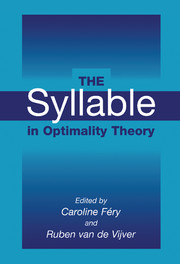Book contents
- Frontmatter
- Contents
- List of Contributors
- Preface
- The Syllable in Optimality Theory
- Part One INTRODUCTION
- Part Two SYLLABLE STRUCTURE AND PROSODIC STRUCTURE
- Part Three NONMORAIC SYLLABLES AND SYLLABLE EDGES
- 6 Syllables and Moras in Arabic
- 7 Semisyllables and Universal Syllabification
- 8 Onsets and Nonmoraic Syllables in German
- 9 Extrasyllabic Consonants and Onset Well-Formedness
- 10 Beyond Codas: Word and Phrase-Final Alignment
- Part Four SEGMENTS AND SYLLABLES
- Part Five HOW CONCRETE IS PHONOTACTICS?
- Author Index
- Languages Index
- Subject Index
9 - Extrasyllabic Consonants and Onset Well-Formedness
Published online by Cambridge University Press: 03 July 2009
- Frontmatter
- Contents
- List of Contributors
- Preface
- The Syllable in Optimality Theory
- Part One INTRODUCTION
- Part Two SYLLABLE STRUCTURE AND PROSODIC STRUCTURE
- Part Three NONMORAIC SYLLABLES AND SYLLABLE EDGES
- 6 Syllables and Moras in Arabic
- 7 Semisyllables and Universal Syllabification
- 8 Onsets and Nonmoraic Syllables in German
- 9 Extrasyllabic Consonants and Onset Well-Formedness
- 10 Beyond Codas: Word and Phrase-Final Alignment
- Part Four SEGMENTS AND SYLLABLES
- Part Five HOW CONCRETE IS PHONOTACTICS?
- Author Index
- Languages Index
- Subject Index
Summary
Introduction
In many languages it has been observed that not all consonants are conveniently assigned a position within a syllable; those that fall outside a syllable are called extrasyllabic. A small sample of researchers who have examined the treatment of extrasyllabic consonants includes Steriade (1982), Clements and Keyser (1983), Borowsky (1986), Ito (1986), Rubach and Booij (1990a, 1990b), Lamontagne (1993), Rialland (1994), Sherer (1994), and Rubach (1997); the chapters by Cho and King, Féry, Kiparsky, and Wiltshire in this volume; and of course many others too numerous to mention here. These researchers have argued that when the potential for an extrasyllabic consonant exists, the consonant may become syllabified through vowel epenthesis, or may be deleted through stray erasure, or may be incorporated into higher prosodic structure. Only in the last case are the consonants in question extrasyllabic on the surface. The members of the prosodic hierarchy considered here include, from bottom to top: syllable (σ), foot (f), and prosodic word (henceforth pword, symbolized ω). See Selkirk 1980, 1984, 1995, Booij 1983, Inkelas and Zec 1995, and many others for discussion of the roles of these elements in the prosodic hierarchy.
In this chapter I examine the behavior of consonant clusters at the left edges of prosodic categories from the perspective of Optimality Theory (OT – Prince & Smolensky 1993), presenting evidence from Icelandic, Attic Greek, and Munster Irish to show that clusters that are not licit syllable onsets may nonetheless be licit left-edge clusters at higher prosodic levels.
- Type
- Chapter
- Information
- The Syllable in Optimality Theory , pp. 238 - 253Publisher: Cambridge University PressPrint publication year: 2003
- 9
- Cited by



